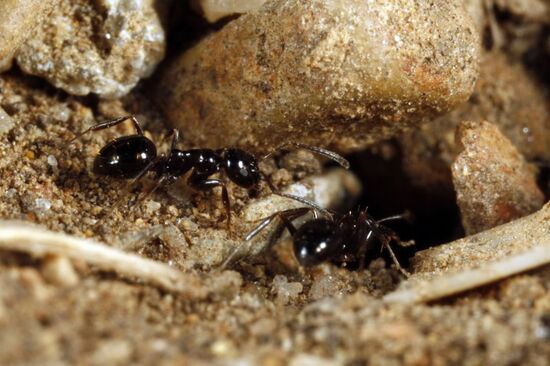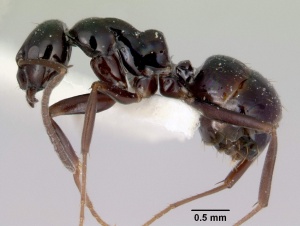Prolasius
| Prolasius | |
|---|---|

| |
| Prolasius advena | |
| Scientific classification | |
| Kingdom: | Animalia |
| Phylum: | Arthropoda |
| Class: | Insecta |
| Order: | Hymenoptera |
| Family: | Formicidae |
| Subfamily: | Formicinae |
| Tribe: | Melophorini |
| Genus: | Prolasius Forel, 1892 |
| Type species | |
| Formica advena, now Prolasius advena | |
| Diversity | |
| 19 species (Species Checklist, Species by Country) | |
Photo Gallery
Identification
Distribution
Distribution and Richness based on AntMaps
Species by Region
Number of species within biogeographic regions, along with the total number of species for each region.
| Afrotropical Region | Australasian Region | Indo-Australian Region | Malagasy Region | Nearctic Region | Neotropical Region | Oriental Region | Palaearctic Region | |
|---|---|---|---|---|---|---|---|---|
| Species | 0 | 19 | 1 | 0 | 0 | 0 | 0 | 0 |
| Total Species | 2841 | 1736 | 3045 | 932 | 835 | 4379 | 1741 | 2862 |
Biology
Association with Other Organisms
All Associate Records for Genus
Click here to show/hide associate data.
| Taxon | Relationship | Associate Type | Associate Taxon | Associate Relationship | Locality | Source | Notes |
|---|---|---|---|---|---|---|---|
| Prolasius advena | host | nematode | Diploscapter formicidae | parasite | Quevillon, 2018 | multiple encounter modes; indirect transmission; transmission outside nest | |
| Prolasius advena | host | nematode | Diploscapter formicidae | parasite | New Zealand | Zhao et al., 2013 |
Life History Traits
- Mean colony size: 200-1470 (Greer et al., 2021)
- Compound colony type: not parasitic (Greer et al., 2021)
- Nest site: hypogaeic; arboreal (Greer et al., 2021)
- Diet class: herbivore; omnivore (Greer et al., 2021)
- Foraging stratum: subterranean/leaf litter (Greer et al., 2021)
- Foraging behaviour: cooperative (Greer et al., 2021)
Castes
Worker of P. nitidissimus from Tasmania.
Morphology
Worker Morphology
 Explore: Show all Worker Morphology data or Search these data. See also a list of all data tables or learn how data is managed.
Explore: Show all Worker Morphology data or Search these data. See also a list of all data tables or learn how data is managed.
• Antennal segment count: 12 • Antennal club: gradual • Palp formula: 6,4 • Total dental count: 5-6 • Spur formula: 1 simple, 1 simple • Eyes: 11-100 ommatidia • Scrobes: absent • Pronotal Spines: absent • Mesonotal Spines: absent • Propodeal Spines: absent • Petiolar Spines: absent • Caste: none or weak • Sting: absent • Metaplural Gland: present • Cocoon: present
Karyotype
Species Uncertain
- Prolasius sp.(ANIC-1): n = 9, 2n = 18 (Australia) (Imai et al., 1977).
- Prolasius sp.(ANIC-2): 2n = 18 (Australia) (Imai et al., 1977).
All Karyotype Records for Genus
- See additional details at the Ant Chromosome Database.
 Explore: Show all Karyotype data or Search these data. See also a list of all data tables or learn how data is managed.
Explore: Show all Karyotype data or Search these data. See also a list of all data tables or learn how data is managed.
Click here to show/hide karyotype data.
Phylogeny
| Formicinae |
| |||||||||||||||||||||||||||||||||||||||||||||||||||||||||||||||||||||||||||||||||||||||||||||||||||||||||||||||||||||||||||||||||||||||||||||||||||||||||||||||||||||||||||||||||||||||||||||||||||||||||||||||||||||||||||||||||||||||||||||||||||||||||||||||||||||||||||||||||
See Phylogeny of Formicinae for details.
Nomenclature
The following information is derived from Barry Bolton's Online Catalogue of the Ants of the World.
- PROLASIUS [Formicinae: Lasiini]
- Prolasius Forel, 1892c: 331 [as subgenus of Lasius]. Type-species: Formica advena, by monotypy.
- Prolasius subgenus of Lasius: Wheeler, W.M. 1910g: 143.
- Prolasius subgenus of Melophorus: Forel, 1917: 248; Emery, 1925b: 13.
- Prolasius raised to genus: Wheeler, W.M. 1922a: 695; Clark, 1934c: 66; Wheeler, W.M. 1935c: 71.
References
- Agosti, D. 1991. Revision of the oriental ant genus Cladomyrma, with an outline of the higher classification of the Formicinae (Hymenoptera: Formicidae). Syst. Entomol. 16: 293-310. (page 296, Prolasius in Formicinae, Lasius genus group)
- Bolton, B. 2003. Synopsis and Classification of Formicidae. Mem. Am. Entomol. Inst. 71: 370pp (page 99, Prolasius in Formicinae, Lasiini)
- Boudinot, B.E., Borowiec, M.L., Prebus, M.M. 2022. Phylogeny, evolution, and classification of the ant genus Lasius, the tribe Lasiini and the subfamily Formicinae (Hymenoptera: Formicidae). Systematic Entomology 47, 113-151 (doi:10.1111/syen.12522).
- Buxton, J.T., Robert, K.A., Marshall, A.T., Dutka, T.L., Gibb, H. 2021. A cross-species test of the function of cuticular traits in ants (Hymenoptera: Formicidae). Myrmecological News 31: 31-46 (doi:10.25849/MYRMECOL.NEWS_031:031).
- Cantone S. 2018. Winged Ants, The queen. Dichotomous key to genera of winged female ants in the World. The Wings of Ants: morphological and systematic relationships (self-published).
- Clark, J. 1934c. Ants from the Otway Ranges. Mem. Natl. Mus. Vic. 8: 48-73 (page 66, Prolasius as genus)
- Dalla Torre, K. W. von. 1893. Catalogus Hymenopterorum hucusque descriptorum systematicus et synonymicus. Vol. 7. Formicidae (Heterogyna). Leipzig: W. Engelmann, 289 pp. (page 181, Prolasius as subgenus of Lasius)
- Donisthorpe, H. 1943g. A list of the type-species of the genera and subgenera of the Formicidae. [part]. Ann. Mag. Nat. Hist. 11(10): 617-688 (page 687, Prolasius in Formicinae, Melophorini; Prolasius as subgenus of Melophorus)
- Emery, C. 1925d. Hymenoptera. Fam. Formicidae. Subfam. Formicinae. Genera Insectorum 183: 1-302 (page 13, Prolasius in Formicinae, Melophorini; Prolasius as subgenus of Melophorus)
- Forel, A. 1892c. Die Ameisen Neu-Seelands. Mitt. Schweiz. Entomol. Ges. 8: 331-343 (page 331, Prolasius as subgenus of Lasius)
- Forel, A. 1917. Cadre synoptique actuel de la faune universelle des fourmis. Bull. Soc. Vaudoise Sci. Nat. 51: 229-253 (page 248, Prolasius in Camponotinae, Meloporini; Prolasius as subgenus of Melophorus)
- Hashimoto, Y. 1990. Unique features of sensilla on the antennae of Formicidae (Hymenoptera). Applied Entomology and Zoology 25: 491-501.
- McAreavey, J. 1947. New species of the genera Prolasius Forel and Melophorus Lubbock (Hymenoptera, Formicidae). Mem. Natl. Mus. Vic. 15: 7-27 (page 9, Prolasius in Formicinae, Melophorini; Prolasius as genus)
- Taylor, R. W.; Brown, D. R. 1985. Formicoidea. Zool. Cat. Aust. 2:1- 149: 1-149, 30 (page 142, Prolasius as genus)
- Wheeler, W. M. 1910b. Ants: their structure, development and behavior. New York: Columbia University Press, xxv + 663 pp. (page 143, Prolasius as subgenus of Lasius)
- Wheeler, W. M. 1922i. Ants of the American Museum Congo expedition. A contribution to the myrmecology of Africa. VII. Keys to the genera and subgenera of ants. Bull. Am. Mus. Nat. Hist. 45: 631-710 (page 695, Prolasius as genus; Prolasius in Formicinae, Melophorini)
- Wheeler, W. M. 1935c. Myrmecological notes. Psyche (Camb.) 42: 68-72 (page 71, Prolasius in Formicinae, Melophorini; Prolasius as genus)






